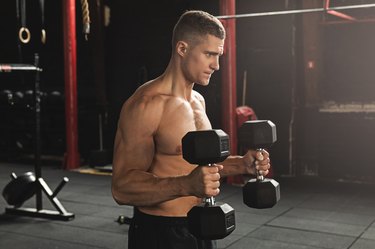
Tweaking the way you do biceps curls can help you target different muscles of your upper arms. And one of the most popular biceps curl variations to help you do just that is the hammer curl.
How to Do a Dumbbell Hammer Curl
Video of the Day
- Start standing with your feet hip-width apart, arms at your sides with a dumbbell in each hand, palms facing in.
- Brace your core and, on an exhale, curl the dumbbells up to your shoulders, keeping your elbows close to your sides.
- Lower the dumbbells back down with control.
Tip
You can also perform hammer curls seated on a sturdy chair or weight bench.
3 Benefits of Hammer Curls
1. Stronger Muscles
The biceps, on the front of your upper arms, are the biggest muscles trained when performing dumbbell hammer curls; however, your brachioradialis also performs a lot of work, according to ExRx.net. The brachioradialis runs from your wrist, across the inside portion of your elbow and into your upper arm bone.
The rotation of your forearms toward your body allows the brachioradialis to contribute more to the upward motion of the hammer curl than traditional curl exercises even though it is smaller than your biceps.
Your brachialis is also worked during these curls and provides important stabilization for your arm as it moves. It also runs across the elbow joint, but is much smaller than the brachioradialis, according to ExRx.net.
Regularly training these muscles with hammer curls will help them grow stronger over time. You'll see even bigger benefits if you strategically build up in weight and/or sets and reps over time, which is called progressive overload.
2. Bigger Biceps
As the three biggest muscles located on the front of your upper arm are being worked, your biceps acclimate to the resistance by getting stronger and growing in size.
You can best target muscle growth — called hypertrophy — by regularly performing 3 to 4 sets of 8 to 12 reps of an exercise using a moderately heavy weight, according to the American Council on Exercise (ACE). Aim for a weight that feels challenging for your final 2 reps, but not so challenging that your form falters.
Plus, your developing brachioradialis will make your forearm muscles look bigger and create the illusion of a smaller elbow joint. That further accentuates the size and shape of your biceps, leading to a perception of even more biceps muscularity.
3. Improved Grip Strength
Your wrist and finger flexors also work when performing dumbbell hammer curls, according to ExRx.net. While these muscles are not the ones being actively trained during hammer curls, they do benefit from the simple task of holding the dumbbells.
The more reps you perform of the dumbbell hammer curl, the longer these muscles must work to keep your hand in a closed position and the better trained they become.
Mix Up Your Upper-Body Routine
Adding variation to your biceps routine is crucial for building strength and muscle. Your biceps work in tandem with other muscles, like those in your back. Multi-joint (or compound) exercises like bent-over rows and pull-ups will complement your dumbbell hammer curls and optimize development of your biceps.
Common Mistakes and Safety Tips
Just like with regular biceps curls, it's important to avoid common curl mistakes when you're doing hammer curls, too. Make sure to follow these safety and form tips:
- Keep your shoulders stable throughout the movement. Don't use your shoulders to swing the weights upward.
- Keep your torso stable and upright throughout the curl. This provides a stability challenge for your core muscles and protects your back.
- Don't arch your lower back, which can lead to back pain.
- Make sure to move through your entire range of motion and don't rush your reps.
- Consider trying some other biceps curls variations during your next arm workout with dumbbells — like Zottman curls — to work different parts of your biceps.
Was this article helpful?
150 Characters Max
0/150
Thank you for sharing!
Thank you for your feedback!